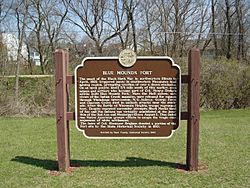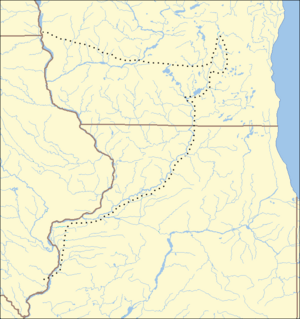Attacks at Fort Blue Mounds facts for kids
Quick facts for kids Attacks at Fort Blue Mounds |
|||||
|---|---|---|---|---|---|
| Part of the Black Hawk War | |||||
 Marker near the site of Fort Blue Mounds. |
|||||
|
|||||
| Belligerents | |||||
| Ho-Chunk | |||||
| Strength | |||||
| 50-100 | |||||
| Casualties and losses | |||||
| 3 KIA | |||||
The attacks at Fort Blue Mounds were two separate events. They happened on June 6 and June 20, 1832. These events were part of the Black Hawk War.
In the first event, people living nearby believed a miner was killed by Ho-Chunk warriors. They thought more Ho-Chunk might join Black Hawk. Black Hawk was fighting against white settlers.
The second event happened east of the fort. A group of Sauk warriors attacked two soldiers. These soldiers were checking on strange noises from the night before. About 50 to 100 warriors were involved. Two soldiers from Fort Blue Mounds were killed.
These attacks happened after the Hall sisters were freed. The sisters had been kidnapped in May. They were brought to Fort Blue Mounds on June 1 by some Ho-Chunk people. Henry Dodge, a militia leader, became suspicious of the Ho-Chunk. He took them prisoner for a short time. This made things more tense between the Ho-Chunk and the settlers. The attacks made people believe that more Ho-Chunk would join Black Hawk. People expected more attacks on the fort. But no more attacks happened. Fort Blue Mounds then became a supply center for the rest of the war.
Contents
Why the Conflict Started: The Black Hawk War Background
The Black Hawk War began because of a land agreement. In 1804, a treaty was made. It was between the Governor of Indiana Territory and some Sauk and Fox leaders. This treaty said the Sauk and Fox tribes had to leave their lands. These lands were in Illinois. They moved west of the Mississippi River in 1828.
However, Chief Black Hawk and others disagreed with this treaty. They said the full tribal councils were not asked. They also said the leaders who signed it did not have the right to give away the land. Black Hawk was angry about losing his birthplace. So, starting in 1830, he led his people back across the Mississippi River several times. Each time, he was convinced to go back without fighting.
In April 1832, Black Hawk tried again. He was promised help from other tribes and the British. He led his group, called the "British Band," into Illinois. This group had about 1,000 warriors and civilians. More fights followed. The state armies of Wisconsin and Illinois were called to find Black Hawk's group. This conflict became known as the Black Hawk War.
Preparing for Trouble: Events Before the Attacks
| Map of Black Hawk War sites Symbols are wikilinked to article |
When settlers heard Black Hawk was back, they quickly built forts. One fort started on May 10. It was at Ebeneezer Brigham's settlement. This place is now Blue Mounds, Wisconsin. Black Hawk did not find the allies he hoped for. He tried to go back to Iowa. But events moved too fast. This led to the Battle of Stillman's Run. This battle likely made the builders of Fort Blue Mounds work faster.
A week after Stillman's Run, on May 21, 1832, the Indian Creek massacre happened. This was far south of Fort Blue Mounds. It was near what is now Ottawa, Illinois. During this attack, two teenage girls were kidnapped. Their names were Sylvia and Rachel Hall. They were taken by a group of Potawatomi raiders.
The girls were released on June 1 at Fort Blue Mounds. A group of Ho-Chunk people helped free them. This group included important chiefs. Henry Dodge, a leader of the Michigan Territory army, arrived to get the girls. But he became suspicious of the Ho-Chunk. He took them prisoner. He hoped this would make other Ho-Chunk in the area stay peaceful. The chiefs were soon released. But tension grew between the white settlers and the Ho-Chunk. Henry Gratiot, an Indian Agent, tried to calm things. He gave gifts to the Ho-Chunk. Despite his efforts, the tension turned into violence a few days later.
The Attacks at Fort Blue Mounds
The first attack near Fort Blue Mounds happened on June 6, 1832. A miner named William Griffith Aubrey was attacked and killed. He was killed by Native American warriors. Before this attack, William Aubrey's wife had an argument with a Ho-Chunk man. The Ho-Chunk man threatened to kill her husband.
Aubrey was working for Brigham about 1.5 miles from Fort Blue Mounds. He and Jefferson Smith were getting water from a spring. They were ambushed by a small group of warriors. Aubrey was shot twice and died. His friend, Smith, was shot three times. But he managed to escape. Smith ran back to the fort. He left his gun and horse behind. At the fort, settlers believed the attackers were Ho-Chunk. They knew it was not Black Hawk's "British Band." Black Hawk's group was about 40 miles away at Lake Kegonsa.
The second attack happened on June 20, 1832. This was two weeks after the first incident. A large Sauk war party attacked Blue Mounds. Two soldiers, Emerson Green and George Force, were killed. People who saw it said the group had between 50 and 100 warriors.
The night before the attack, strange noises were heard near the fort. Force and Green left the fort on horseback to check these noises. They were several miles east of Fort Blue Mounds. There, they met Black Hawk's group. Some Ho-Chunk who supported Black Hawk had guided them to the fort. Force was killed right away. Green tried to run back to the fort. He almost made it to safety. But his horse was shot from under him. This happened in front of the people at the fort. Green was surrounded by the war party and killed.
What Happened Next: After the Attacks
After Aubrey's death, people quickly thought the Ho-Chunk were involved. This made people more afraid. They worried that more Ho-Chunk would join Chief Black Hawk's group. This would mean fighting against white settlers in Michigan Territory and Illinois. If the Ho-Chunk were not loyal, it could mean fighting on two sides.
After Green and Force died, U.S. officers questioned two captured Ho-Chunk warriors. These warriors were from the Prophet's Band. They said they were responsible for the killings. They even bragged about it.
Aubrey was killed near what is now Blue Mounds, Wisconsin. After his death, soldiers from the fort followed the attackers. They found a recently empty camp. Then they followed tracks to the Wisconsin River. The search ended there. Aubrey was buried on a high piece of land. It overlooked the fort from the northeast.
Green's body was buried at the fort. Force was buried near the fort. His grave was along the main trail, about two miles east of the fort.
Brigham expected a full attack on Fort Blue Mounds. But it never came. The only violence at the fort happened to those who left it on June 6 and June 20. Dodge left some soldiers at the fort for a while. But after the June 20 attack, the fort was never attacked again during the Black Hawk War. Until the war ended, Fort Blue Mounds was mostly a supply center. It helped the soldiers as they chased Black Hawk across Wisconsin.
Images for kids





